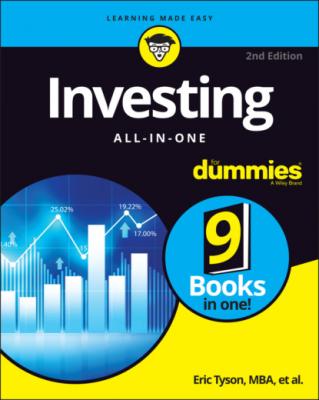Investing All-in-One For Dummies. Eric Tyson
Чтение книги онлайн.
Читать онлайн книгу Investing All-in-One For Dummies - Eric Tyson страница 27
 for financial independence or retirement
for financial independence or retirement
Saving and investing money can make you feel good and in control. Ultimately, most folks are investing money to accomplish particular goals. Saving and investing for a car purchase, expenses for higher education, a home purchase, new furniture, or a vacation are typical short-term goals. You can also invest toward longer-term goals, such as your financial independence or retirement decades in the future.
This chapter discusses how you can use investments to accomplish common shorter- and longer-term goals.
Setting and Prioritizing Your Shorter-Term Goals
Unless you earn really big bucks or expect to have a large family inheritance to tap, your personal and financial desires will probably outstrip your resources. Thus, you must prioritize your goals.
One of the biggest mistakes people make is rushing into a financial decision without considering what’s really important to them. Because many people get caught up in the responsibilities of their daily lives, they don’t take time for reflection often because they feel that they lack the time. Take that time, because people who identify their goals and then work toward them, which often requires changing some habits, are far more likely to accomplish something significant.
This section discusses common “shorter-term” financial goals — such as establishing an emergency reserve, making major purchases, owning a home, and starting a small business — and how to work toward them. Accomplishing such goals almost always requires saving money.
Accumulating a rainy-day fund
The future is unpredictable. Take the uncertainty simply surrounding your job: You could lose your job, or you may want to leave it.
Consider what happened in 2020 with the COVID-19 pandemic and the unexpected and lengthy government-mandated shutdowns in some parts of the country, which led to large layoffs in particular industries like restaurants, retail, and travel-related businesses. While the 2020 recession was unusual in many respects, recessions aren’t unusual, and even when the overall economy is growing, some employers let employees go. Suppose an elderly relative, for example, needs some assistance for a period of time? You don’t need to be negative or a pessimist, but problems happen, and sometimes financial downsides can come with them.
Because you don’t know what the future holds, preparing for the unexpected is financially wise. Enter the emergency or rainy-day fund.
Three months’ living expenses: When you’re starting out, this minimalist approach makes sense if your only current source of emergency funds is a high-interest credit card. Longer-term, you could make do with three months’ living expenses if you have other accounts, such as a 401(k), or family members and close friends whom you can tap for a short-term loan.
Six months’ living expenses: If you don’t have other places to turn for a loan, or if you have some instability in your employment situation or source of income, you need more of a cushion.
Twelve months’ living expenses: Consider this large stash if your income fluctuates greatly or if your occupation involves a high risk of job loss, finding another job could take you a long time, or you don’t have other places to turn for a loan.
Saving for large purchases
Most people want things — such as furniture, a vacation, or a car — that they don’t have cash on hand to pay for. Save for your larger consumer purchases to avoid paying for them over time with high-interest consumer credit. Don’t take out credit card or auto loans — otherwise known as consumer credit — to make large purchases.
And don’t be duped by a seemingly low interest rate on, for example, a car loan. You could get the car at a lower price if you don’t opt for such a loan.
Investing for a small business or home
In your early years of saving and investing, deciding whether to save money to buy a home or to put money into a retirement account (for the tax benefits and to work toward the goal of future financial independence) presents a dilemma. In the long run, owning your own home is usually a wise financial move. On the other hand, saving sooner for retirement makes achieving your goals easier and reduces your income tax bill.
Presuming that both goals are important to you, you can save toward both goals: buying a home and retiring. If you’re eager to own a home, you can throw all your savings toward achieving that goal and temporarily put your retirement savings on hold.
When saving money for starting or buying a business, most people encounter the same dilemma they face when deciding to save to buy a house: If you fund your retirement accounts to the exclusion of earmarking money for your small-business dreams, your entrepreneurial aspirations may never become reality. Consider hedging your bets by saving money in your tax-sheltered retirement accounts as well as toward your business venture. An investment in your own small business can produce great rewards, so you may feel comfortable focusing your savings on your own business.
Saving for kids’ higher educational costs
Do you have little ones or plan to have them in your future? You probably know that rearing a child (or two or more) costs really big bucks. But the biggest potential expense awaits when they reach young adulthood and consider heading off to college, so your instincts may be to try to save money to accomplish and afford that goal.
This concept